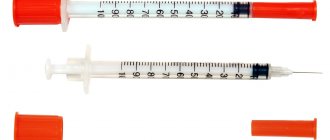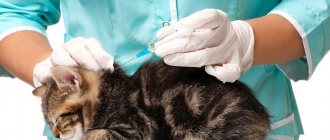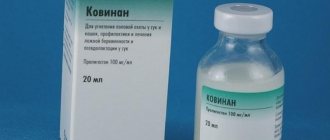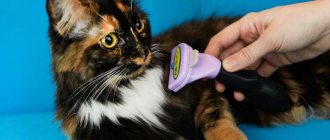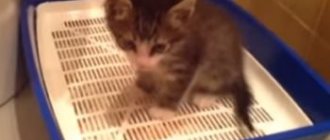Ekaterina Shulga
veterinary therapist
Veterinarians often prescribe subcutaneous injections to your pet, and the most common place for them is at the withers. Let's look in detail at how to give an injection to a cat at the withers at home. This skill will reduce the animal’s stress from going to the clinic and save your time.
- Choosing a syringe and needle
Where is the withers located in cats?
Let's figure out where to look for a cat's withers. The withers are the area where the back and neck connect. Most of it is located immediately above the shoulder blades; the skin in this place easily folds, creating a “pocket” where the injection can be made.
Why are injections given at the withers?
To quickly administer the drug and reduce pain, an injection is given to the cat at the withers. The area above the shoulder blades is insensitive, and when injected under the skin, the pet experiences virtually no uncomfortable sensations. The loose structure of the subcutaneous tissue, if necessary, allows the introduction of large volumes of solutions, thus conducting infusion therapy (droppers).
Other sites for hypodermic injections in cats
In addition to the withers, you can choose other places for subcutaneous injections. For example, the groin fold or the front of the thigh. The loose structure of the skin in these places makes the injection almost painless. Some drugs are even recommended to be placed specifically in the inguinal fold. It is recommended to place vaccines in the area of the inguinal fold, because this makes it easier to remove post-vaccination sarcoma if a complication occurs.
Preparing for the injection
To give an injection to a cat at the withers, you need to be fully armed. Select a syringe, prepare the drug and place for the procedure. If the pet is cowardly or aggressive, find a helper to secure the animal and secure it. To avoid additional stress for your cat, carry out the procedure in a quiet and calm atmosphere. Talk to her, pet her, calm her down. To distract your cat from manipulation, you can offer her treats.
Choosing a syringe and needle
The choice of syringe and needle depends on the size of the animal and the consistency of the drug. If the drug is oily, it is better to choose a needle with a thicker diameter. The thin needle will become clogged and the injection will not be possible. Also, if the drug is oily or in the form of a suspension, the procedure will cause more discomfort. The pet may jerk, causing the thin needle to bend. Therefore, to administer such drugs to adult cats, you can use a 5-10 ml syringe needle, and to kittens - 2-3 ml. If the drug is liquid, then we look at the size of the pet, the thickness of the skin and subcutaneous tissue. For kittens and very thin animals, a needle from an insulin syringe (1 ml) is enough; for more plump cats, a needle from a syringe 2-3 ml. That is, if you are giving an oil preparation to a kitten, you can take a large needle and an insulin syringe - this will make it more convenient to draw a small dose of the solution and inject it without any problems.
Preference is always given to short needles up to 3 cm - this way we reduce the risk of puncturing the skin through, introducing the drug into the muscle or trauma to the skin.
Each syringe has a scale. Depending on its volume, you can draw 1.0 ml, 2.0 ml, 3.0 ml, 5.0 ml, 10 or 20 ml of solution. Most often, 1-5 ml syringes are used for animals. The division features depend on the volume of the syringe, the volume is measured in cubes, one cube is equal to 1 ml:
- in a 1 ml syringe, large divisions are equal to 0.1 ml, small divisions are 0.01 ml;
- in a syringe with a volume of 2.0 ml, large divisions are 1.0 ml, small divisions are 0.1 ml;
- in a syringe with a volume of 5.0 ml, large ones are equal to 1.0 ml, and small ones are 0.2 ml, etc.
Preparing the medicine
Be sure to read the instructions for the drug. Requirements for its storage may differ in temperature - room or in the refrigerator, in access to light - some drugs should be stored in dark places or in dark containers.
Before the injection, it is necessary to warm the drug to body temperature, but not higher than 37 C. To do this, just hold the syringe with the drug in your hand for a few minutes. Most solutions cause discomfort in cats when administered cold.
Prepare the syringe and ampoule. Remove the syringe from the sterile packaging and check that the needle is firmly seated on the cannula. If the ampoule is glass, open it along the marked line by simply pressing it through a cotton pad. Some of them do not have such a mark, in this case, in the thinnest place, run the blade several times (it is usually included in the package of the drug) and press the same way. If it is a bottle and there is a rubber stopper on it, then you do not need to open it. We insert a needle into its center and draw up the drug. If there is protection on the plug - plastic or metal, it must be removed.
Tilt the ampoule slightly to one side, remove the cap from the needle and draw the required amount of the drug into the syringe.
After drawing the drug, lift the syringe with the needle up and release the air until the first drop of solution comes out of the needle. Put the cap back on. Check the dose taken, it should be equal to what the doctor prescribed for your cat. Warm the drug in your hand. If you cannot remove air from the syringe, the drug is foaming or thick, lightly tapping the syringe with your fingers and moving the piston up and down until all the bubbles are released. Also, first you can take the drug and warm it, and only after that - remove the air. So, most foam bubbles will burst on their own.
How to keep a pet?
If you have never given injections to your cat before, no matter the nature of your pet, it is worth being on the safe side.
There are special retainer bags. This bag is a kind of cocoon with locks or Velcro on different parts of the animal’s body. It allows you to isolate some part of the animal for the procedure - paw, tail, back. A soft clamp is fastened around the head, and it remains outside. However, as practice shows, such a bag is not ideal. Many cats become nervous and angry even at the stage of placing them in the bag. Also inside the bag, the cat's paws are free, and animals can stick them into the head hole or tear them with their claws.
In addition to paws with claws, teeth also pose a threat. To protect against them, use a muzzle. There are special muzzles for cats made of thick fabric; they completely cover the face and eyes, and are secured with Velcro behind the ears.
Hurry up, choose a box and find out what gift awaits you
Discount on pet insurance
Promo code copied to clipboard
To ensure your safety from cat teeth, a muzzle made from a plastic bottle is the best life hack. To make it, you need a bottle that is the right size for your pet. If you have a kitten, then you need a 0.5 liter bottle, if you have a large British cat, we take a wide 1.5–2.0 liter bottle. In the place where the neck is, depending on the size of your cat’s head, cut off a part of the bottle 10–15 cm long. Remove sharp edges by covering the cut with electrical tape or adhesive tape if the cut was uneven. Next, on its wide part, at an equal distance from each other, we make holes. We insert ties into them. Unscrew the cap, put it on your head and tie it tightly behind your ears.
Swaddling a cat is an excellent method of restraint that will help not only give an injection, but also give a pill if necessary. Take a large, thick towel/blanket/sheet/shirt and place it on top of the cat so that the head remains open. Pull the right edge of the towel to the left, tightly fixing the paw to the chest, and the left edge to the right. The ends of the towel should be on your back. Keep them taut. Fix the front paws, tuck the remaining free part of the towel from the tail side under the belly and firmly press the resulting cocoon with the cat to a horizontal surface. The denser the resulting cocoon, the less ability and desire the cat has to move. Or, if you have a helper, you can throw a towel over the cat. Press her to a horizontal surface with your chest, and hold her front paws with your hands. The second person administers the injection.
It is always important to calm your pet. If he is very scared, it is better to stop the procedure and give him time to calm down.
Important Rules
Before proceeding directly to the procedure, owners should study a number of important rules, or even, rather, requirements:
- It is prohibited to mix drugs in one syringe unless directed by the doctor.
- The procedure itself should be performed only with clean hands. The sterility of not only the instrument itself, but also its needle is also important.
- If the ampoule contains a cold drug, you should first warm it up in your palms to body temperature.
- After drawing the medicine into the syringe, it is necessary to lift it up with the needle and release all air bubbles by pressing the piston. In this case, a few drops of solution will be squeezed out - a necessary measure.
We now know where to give a cat an intramuscular injection, but as for kittens, there are no special rules in this case.
It’s just that the owners should act more carefully, since the scope for manipulation is limited. The only difference is not in the method of administration of the drug, but in its dosage.
General recommendations
Do not panic. The more afraid you are, the more unnecessary movements and sounds you will make that can frighten the cat. Your pet may sense something is wrong and begin to panic before you even begin to notice.
In order not to be distracted by searching, prepare everything you need in advance and put it within reach.
Carry out the procedures at rest. For example, when the cat has just woken up or started its normal daily activities. Do not perform the procedure when she is angry, playful, or completely in the mood for contact with you.
Calm your pet and talk to him throughout all manipulations.
If at the time of injection you see that the fur has become wet, then you have pierced the skin right through and the solution has begun to flow out. It is worth stopping the procedure.
We give the correct injection to the cat at the withers - step-by-step instructions
Let's consider point by point how to correctly inject a cat at the withers subcutaneously.
- Open the ampoule. Take the drug in the required dose and release the air. Warm it in your hand. Remove the cap from the needle immediately before delivering the injection.
- Grab the cat's skin between the shoulder blades with your fingers to form a small “pocket.” This will be the injection site for the drug. Massage the skin a little with your fingers, this will distract the cat's attention from the sensation of the injection.
- Take the syringe with your other hand, tilt the needle towards the cat's body at an angle of 40-45°, insert the needle about 1 cm. When you pierce the skin, you will feel the needle sink in and there is no resistance. This means that the puncture was performed correctly, and that is enough.
- Start injecting the solution. Don't do it too abruptly, but don't drag it out either. If the drug is liquid, administer it quickly, and a little slower if it is a suspension or oily solution. If you inject the solution too quickly, it may become painful, and if you inject it too slowly, your cat may become impatient and resist.
- Gently remove the needle and release the skin. There is no need to treat the injection site, as the fur will get in the way. If you have a Sphynx, or you have shaved the injection site, then treat the skin with chlorhexidine before and after the procedure.
- Release your pet. If he doesn't mind, you can pet him and put him to rest.
Preparatory stage
Since an injection for pets is somewhat reminiscent of an operation, then, like any procedure, it should only be carried out under sterile conditions! In general, an intramuscular injection (we already know where to inject an injection into the thigh of a cat) is not difficult, but everything must be done correctly. Otherwise, you should not hope for effective treatment.
In addition, it is important to use only those medications that are prescribed by a veterinarian, and not on the advice of a neighbor - they say, he treated his cat this way. In each specific case, diagnosis is important, and only after it has been carried out can the doctor prescribe the necessary course of treatment. Therefore, it is better not to self-medicate and leave the choice of drugs to a specialist.
It is worth considering that cats feel like masters in their own territory, and if they are scared or in an aggressive state, then the owner runs the risk of being bitten or scratched.
Injection in the withers of a kitten
There are several features of how to give an injection to a kitten at the withers. Basically, they are related to its size and skin thickness. When injecting, insulin syringes are used and a needle is inserted 0.5–0.7 cm.
Also, if the volume of the solution is too large, then it is better to inject it into several places.
Be careful when restraining the animal. If the kitten is small, you can use its innate reflex. Your assistant takes the kitten by the scruff of the neck - as if its mother was carrying it, and it instinctively relaxes, tucks its hind legs and tail. This way you can deliver the injection safely and without resistance.
Heat
A slight increase in the animal’s body temperature after injection is considered an adequate reaction of the body.
- But if the high temperature persists for more than 3 days, then you need to immediately go to the veterinary clinic.
- Typically, this complication is associated with an allergy to a drug or the development of an inflammatory process.
We hope that this material was useful to you, and now you can give your cat an injection yourself. Good luck!
Is it possible to give an injection incorrectly?
In this article, we discussed in detail how to correctly inject a cat in the withers subcutaneously. Everything is quite simple, and if you follow the instructions of the doctor and the drug, it is almost impossible to perform the procedure incorrectly.
The main thing is to secure the pet well and choose the right syringe and needle.
If you insert the syringe too deeply, the solution will get into the muscle. It can also leak because you pierced the skin all the way through. If the needle is not inserted deep enough, the injection will be intradermal, which is quite painful and can cause some complications.
Features of intramuscular injections
When performing an intramuscular injection, the drug is delivered directly into the muscle tissue.
Any medical procedure has certain disadvantages and advantages.
The obvious advantages include the following:
- An intramuscular injection can be given independently by anyone who does not have special medical or veterinary skills.
- The slow, gradual supply of the drug makes it possible to dose the drug into the bloodstream and maintain a stable concentration of drugs in the animal’s body.
Disadvantages include pain when a large number of drugs that have an irritating effect are injected into the muscle. The muscle tissues are quite well innervated due to the developed circulatory system, so the injection can be quite painful for the pet.
Complications after the injection
Always pay attention to your doctor's recommendations. Subcutaneously or at the withers - drugs are always administered only as prescribed by a doctor. If the drug according to the instructions is not to be administered subcutaneously, but only intramuscularly or intravenously, local reactions may occur - inflammation, pain, necrosis, abscesses. In this case, after a few hours, swelling and a hot lump will appear at the injection site, and the pet will feel unwell. Itching may appear, and pus may discharge from the injection site.
When blood vessels are damaged , bleeding
usually minor and goes away quickly on its own. You can apply ice to speed up this process.
After any injection, and subcutaneous injection is no exception, a hematoma
.
Seal
at the injection site - a common complication when administering drugs subcutaneously, especially if they are thick. It should not be hot, not painful, and should not bother the cat. Otherwise, it is better to contact a veterinarian.
Animals may have an individual reaction to the drug
. Unfortunately, it will not be possible to find out in advance about its availability. In case of a general reaction, the symptoms will be: itching, shortness of breath, redness of the mucous membranes, confusion. With local - extensive swelling in the injection area, usually painful and soft.
Cellulitis
– a rare, but still occurring complication after injection. This is a condition in which purulent inflammation of the soft tissue occurs at the injection site as a result of microorganisms. It can occur if basic rules of hygiene and antiseptics are not followed. It is necessary to use disposable syringes and needles, wash hands before procedures, use sterile preparations and, if there is no fur, treat with antiseptics.
Possible difficulties
For a non-specialist, giving an intramuscular injection can be difficult, especially for the first time. It must be remembered that anxiety is transmitted to the pet, so it is very important to remain calm. The injection is necessary in order to help the animal, so there is absolutely no need to feel guilty.
If after an intramuscular injection blood appears on the surface of the skin or fur, this is considered normal. But if the bleeding does not stop, then you need to apply something cool to the manipulation site for 15-20 minutes. It is important not to overdo it and not to overcool the injection site.
Lameness may persist for some time from the injection of painful drugs, but if the limb hangs lifelessly and has lost mobility, this is a reason to seek advice from a specialist.
Are you afraid to give injections to your cat?
It’s natural to worry about your pet when administering an injection yourself. But, as we see, everything is quite simple. A subcutaneous injection cannot cause critical harm to your pet.
To overcome your fear, you can ask your doctor to show you how to perform the procedure correctly at your appointment and practice on plush toys.
Invite a support group; starting something new is always not so scary together.
Remind yourself that this is for the benefit of your pet. If not you, then who?
To visually understand how to perform this procedure, we suggest watching a video on how to inject a cat at the withers.
The appearance of abscesses
Swelling and ulcers after injection can only appear if you performed this procedure incorrectly. A dangerous microorganism or bacterium penetrates into a small wound, resulting in an infection, accompanied in most cases by tissue inflammation.
The swelling may go away on its own after some time. If this does not happen, then an abscess forms, they are already removed through surgery, after the operation the veterinarian prescribes a course of anti-inflammatory drugs.
